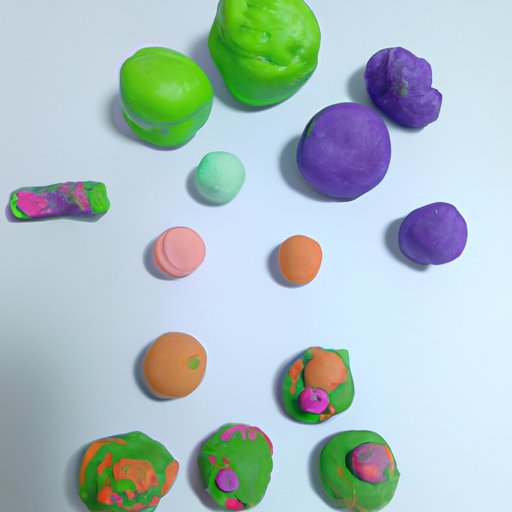
Introduction
Do you struggle to find good quality playdough in stores? Are you tired of it drying out quickly or leaving stains on clothes? If so, it’s time to try making your own homemade playdough! This article will provide you with step-by-step instructions, benefits, creative recipes, alternative ingredients, tips and tricks, and fun activities for making homemade playdough.
Step-by-Step Guide to Making Playdough
To make your own homemade playdough, you will need:
- 2 cups of flour
- 1 cup of salt
- 2 tablespoons of cream of tartar
- 2 tablespoons of vegetable oil
- 1.5 cups of boiling water
- Food coloring or natural dyes
Follow these steps:
- Mix flour, salt, and cream of tartar in a large bowl.
- Stir in vegetable oil and hot water. Mix until smooth.
- Add food coloring or natural dyes. Knead until the desired color is reached.
- Store in an airtight container in the refrigerator for up to 6 months.
Troubleshooting tips:
- If the dough is too sticky, add extra flour until the desired consistency is reached.
- If the dough is too dry, add a small amount of water and knead the dough until it becomes smooth.
Benefits of Making Homemade Playdough
Making your own playdough has many benefits over store-bought ones. Homemade playdough is:
- Cost-effective
- Customizable with natural ingredients and scents
- Free of chemicals and toxins
- Long-lasting
Here is a basic recipe for making homemade playdough:
- 2 cups of flour
- 1 cup of salt
- 2 tablespoons of cream of tartar
- 2 tablespoons of vegetable oil
- 1.5 cups of boiling water
Creative Recipes for Playdough
Take your playdough to the next level with these creative recipes:
- Use natural dyes like turmeric, beetroot, or spinach to color your playdough.
- Add essential oils or spices like cinnamon, lavender, or peppermint to add a beautiful scent to your playdough.
- Experiment with alternative ingredients like gluten-free flour or vegetable-based colors to make your playdough unique.
Tips and Tricks for Successful Playdough Making
To keep your playdough fresh and fun for longer, here are some tips:
- Store your playdough in an airtight container in the refrigerator.
- To avoid drying out, use a damp cloth to cover the playdough when not in use.
- If the playdough seems dry, add a small amount of water and knead the dough until it becomes smooth again.
Playdough-Based Activities and Games for Kids
There are many fun activities and games you can do with playdough. Here are a few ideas:
- Create fun shapes and patterns with cookie cutters or playdough tools.
- Make playdough animals, flowers, cities, and nature scenes.
- Engage children in sensory play with different textures by adding rice, beans, or pasta to your playdough creations.
Using Playdough in Learning and Development
Playing with playdough is not only fun but also beneficial for children’s learning and development. Here are some ways to incorporate playdough into your child’s education:
- Use playdough to teach shapes, colors, and numbers.
- Encourage imaginative play and storytelling by using playdough to create characters and settings.
- Develop fine motor skills by manipulating playdough.
Conclusion
Congratulations, you are now a playdough expert! Making homemade playdough is a cost-effective, customizable, and creative way to entertain children while offering educational benefits. Remember to store your playdough in the refrigerator for maximum freshness and to try different recipes, colors, and scents to make playdough even more fun.





